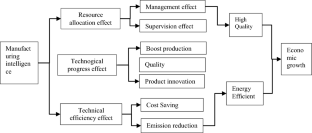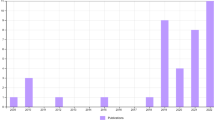Abstract
Manufacturing intelligence is an important starting point to achieve high-quality economic growth. Based on the non-radial and non-angular DEA-SBM model, combined with the Malmquist index method, this paper calculates the total factor productivity and green total factor productivity of 286 prefecture-level cities in China, which are used as the indicators of high-quality economic growth. At the same time, the proxy variables of manufacturing intelligence are further constructed, and the impact of intelligent manufacturing on high-quality and energy-efficient economic growth is empirically analyzed. It is found that intelligent manufacturing significantly promotes China’s high-quality and energy-efficient economic growth. Productivity is further decomposed into specific indicators such as technical efficiency, technological progress, pure technical efficiency, pure technical progress, scale efficiency and scale technology, and the mechanism of intelligent manufacturing is analyzed from multiple angles. The research finds that manufacturing intelligence improves the total factor productivity through technological progress effect. Green total factor productivity has been improved through the improvement of technical efficiency effect, but the development of intelligence has brought new challenges to China's labor market. In order to further develop the potential of intelligence, it is necessary to further improve the enterprises’ scale efficiency, while increasing the research and development of energy technology.

Similar content being viewed by others
References
Acemoglu D, Restrepo P (2017) Robots and jobs: evidence from US labor markets. NBER Working Paper no 23285
Acemoglu D, Restrepo P (2018) Artificial intelligence, automation and work. Social Science Electronic Publishing
Acemoglu D, Restrepo P (2020) Robots and jobs: evidence from US labor markets. J Polit Econ 128(6):2188–2244
Anderson MC, Banker RD, Janakiraman SN (2003) Are selling, general, and administrative costs “sticky.” J Account Res 41(1):47–63
Andrews D, Criscuolo C, Gal PN (2016) The best versus the rest: the global productivity slowdown, divergence across firms and the role of public policy. Oecd Productivity Working Papers
Ang JB, Madsen JB, Islam MR (2011) The effects of human capital composition on technological convergence. J Macroecon 33(3):465–476
Autor DH, Salomons A (2017) Robocalypse now:does productivity growth threaten employment? ECB Sintra Forum on Central Banking papers
Autor DH, Levy F, Murnane RJ (2003) The skill content of recent technological change: an empirical exploration. Q J Econ 118(4):1279–1333
Autor D, Dorn D, Lawrence F, Patterson C, Van Reenen J (2017) The fall of the labor share and the rise of superstar firms. NBER Working Paper 23396, Cambridge, MA
Baumol W (1967) Macroeconomics of unbalanced growth: the anatomy of urban crisis. Am Econ Rev 57:415–426
Binder CR, Mühlemeier S, Wyss R (2017) An Indicatorbased approach for analyzing the resilience of transitions for energy regions. Part I: theoretical and conceptual considerations. Energies 10(36):1–18
Brynjolfsson E, Rock D, Syverson C (2019) Artificial intelligence and the modern productivity paradox: a clash of expectations and statistics. Social Science Electronic Publishing
Byrne DM, Fernald JG, Reinsdorf MB (2016) Does the United States have a productivity slowdown or a measurement problem?. Brookings Papers on Economic Activity.
Cai Y, Chen N (2019) Artificial Intelligence and high-quality growth and employment under the new technological revolution. J Quant. Tech. Econ. 36(05):3–22
Dai J, Ahmed Z, Pata UK, Ahmad M (2023) Achieving SDG-13 in the era of conflicts: the roles of economic growth and government stability. Eval Rev 47:1168–1192
Dai J, Hiung EYT, Destek MA, Ahmed Z (2024) Green policymaking in top emitters: assessing the consequences of external conflicts, trade globalization, and mineral resources on sustainable development. Int J Sustain Dev World Ecol, 1–15.
Dauth W, Findeisen S, Sidekum J (2017) German robots-the impact of industrial robots on workers. CEPR Discussion Papers, No DP12306
Fan S, Zhang X (2004) Infrastructure and regional economics development in rural China. China Econ Rev 15:203–214
Frankel JA, Romer DH (1999) Does trade cause growth? Am Econ Rev 89(3):379–399
Frey CB, Osborne MA (2017) The future of employment: how susceptible are jobs to computerisation? Technol Forecast Soc Change 114:254–280
Gordon RJ (2018) Why Has economic growth slowed when innovation appears to be accelerating?. Nber Working Papers
Graetz G, Michaels G (2015) Robots at Work. CEP Discussion Paper no 1335
Grubler A (2004) Transitions in energy use. Encycl Energy 6:163–177
Hanson R (2001) Economic growth given machine intelligence, Technical report, University of California Berkeley
Hunjra AI, Bouri E, Azam M, Azam RI, Dai J (2024) Economic growth and environmental sustainability in develo** economies. Res Int Bus Finance 70(1):102341
Irandoust M (2016) The renewable energy-growth nexus with carbon emissions and technological innovation: evidence from the Nordic countries. Ecol Indic 69:118–125
Javorcik BS (2004) Does foreign direct investment increase the productivity of domestic firms? In search of spillovers through backward linkages. Am Econ Rev 94(3):605–627
Jones CI (2002) Introduction to economic growth. J Econ Theory 147(2):545–550
Kou J, Sun F (2020) An analysis on the promotion and prospect of scientific and technological innovation for China’s energy transformation. Sci Technol Manag Res 40(16):244–250
Li C (2015) Review on the “export-productivity paradox” of Chinese enterprises. World Econ 038(005):148–175
Li L, Bao Y, Liu J (2020) Study on the impact of Intellectualization on the total factor productivity of China’s manufacturing industry. Stud Sci Sci 252(04):36–45
Li L, Zhou S, Xu W, Dai J (2024) Green innovation's impact on corporate financing: new insights from BRICS economies. Finance Res Lett 62(Part B):105172
Lin JY (2015) The Washington Consensus revisited: a new structural economics perspective. J Econ Policy Reform 18(2):96–113
Lin J, Monga C (2011) Growth identification and facilitation?: The role of the state in the dynamics of structural change. Dev Policy Rev 29(3):264–290
Liu H, Khan I, Zakari A, Alharthi M (2022) Roles of trilemma in the world energy sector and transition towards sustainable energy: a study of economic growth and the environment. Energy Policy 170:113238
Lv L, Deng Z, Liu T, Li Z, Liu W (2020) Intelligent technology in grinding process driven by data: a review. J Manuf Process 58:1039–1051
Lv Jie Du, Chuanwen LY (2017) Will the application of industrial robots force the transformation of labor structure in a country’s manufacturing industry? Based on the experience analysis of 22 countries from 1990 to 2015. Sci Technol Manag Res 22:32–41
Murshed M, Mahmood H, Ahmad P, Rehman A, Alam S (2022) Pathways to Argentina’s 2050 carbon-neutrality agenda: the roles of renewable energy transition and trade globalization. Environ Sci Pollut Res 29(20):29949–29966
Reyes-Mercado P, Rajagopa L (2017) Adoption of renewable energy technologies in Mexico: the role of cognitive factors and innovation attributes. Int J Energy Sect Manag 11(4):626–649
Song X, Zuo MH (2019) Input, labor supply and labor productivity of industrial robots. Reform 9:45–54
Tabrizian S (2019) Technological innovation to achieve sustainable development: renewable energy technologies diffusion in develo** countries. Sustain Dev 27(3):537–544
Wang Y, Dong W (2020) How is the rise of robots affecting China’s Labour market?–Evidence from listed manufacturing companies. Econ Res 55(10):159–175
Wang Z, Huang Y, Ankrah V, Dai J (2023) Greening the knowledge-based economies: Harnessing natural resources and innovation in information and communication technologies for green growth. Resour Policy 86:104181
Wang B, Wang J, Dong K (2024) How does artificial intelligence affect high-quality energy development? Achieving a clean energy transition society. Energy Policy 186:114010
Xu R, Pata UK, Dai J (2023) Sustainable growth through green electricity transition and environmental regulations: do risks associated with corruption and bureaucracy matter? Politická ekonomie. In press
Yang G, Hou Y (2020) The use of industrial robots, technological upgrading and economic growth. China Industrial Econ 391(10):140–158
Yao S, Zhang Z (2001) Regional growth in China under economic reforms. J Dev Stud 38(2):167–186
Yuan C, **ao T, Geng C, Sheng Y (2021) Digital transformation and division of labor between enterprises: Vertical specialization or vertical integration. China Industrial Econ 9:137–155
Zeira J (1998) Workers, machines, and economic growth. Quart J Econ 113(4):1091–1117
Acknowledgements
This work was sponsored by Humanities and Social Sciences Research Fund of the Ministry of Education(21YJC790041); National Natural Science Foundation of China (72363017); Science and Technology Research Project of Jiangxi Provincial Department of Education(GJJ210514); The 71st China Postdoctoral Science Foundation project (306895).
Author information
Authors and Affiliations
Corresponding author
Ethics declarations
Conflict of interest
The authors declare that they have no known competing financial interests or personal relationships that could have appeared to influence the work reported in this paper.
Additional information
Publisher's Note
Springer Nature remains neutral with regard to jurisdictional claims in published maps and institutional affiliations.
Rights and permissions
Springer Nature or its licensor (e.g. a society or other partner) holds exclusive rights to this article under a publishing agreement with the author(s) or other rightsholder(s); author self-archiving of the accepted manuscript version of this article is solely governed by the terms of such publishing agreement and applicable law.
About this article
Cite this article
**a, L., Han, Q. & Yu, S. Sustainable manufacturing intelligence: pathways for high-quality and energy efficient economic growth. Econ Change Restruct 57, 100 (2024). https://doi.org/10.1007/s10644-024-09692-z
Received:
Accepted:
Published:
DOI: https://doi.org/10.1007/s10644-024-09692-z




